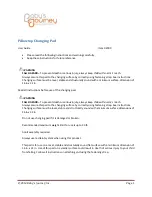
4
o
p e r a t i o n
a n d
S
a F e t y
This is a quick guide for those new to Multi-Rotor craft offering
some basic safety and operational procedures...and are
recommended standard operating procedures for those piloting
Droidworx or any multi-rotor craft.
Please read the instructions for the relevant Flight Control
electronics before proceeding. Go to the web site of your flight
control system and make yourself well acquainted with the correct
procedure for the electronics installation and software operation.
Caution: never connect and start the engines for the first time with
the propellers attached....and always balance your propellers;
unbalanced propellers can cause excessive vibration which may
lead to material fatigue.
Note:
check the orientation of the flight controller you are using
(which way is front) and also the engine assignment configuration;
for instance which is engine 1,2,3 etc. and check also that your
propellers, clockwise and counter clockwise, are also installed
correctly before your first flight.
Before the first flight hand test your craft – arm and calibrate your
electronics, hold the craft with both hands by the landing gear
skids above your head with the front facing away from, and to
the front of you, make sure you are well clear of obstructions and
other people. You may need the assistance of another person
for this test. Raise the throttle to around 25% and gently move
the craft around the axis’ roll (tipping the craft left and right) and
feel for a steady and smooth resistance to your movements, do
the same for pitch (tipping the craft forward and backward) and
also yaw, rotating the craft clockwise and anti-clockwise whilst
keeping it horizontal. If the craft offers smooth resistance to your
movements it will fly correctly.
Your first test flight should be in an open field in low or zero wind.
A sports field (not currently in use) is a good option; choose a site
with short or mown grass. Do not takeoff from dry dusty sites.
Make sure any onlookers or spectators do not gather about you…
if so ask them to move away from you in a perimeter not less than
50m (150 feet) diameter around you.
Make sure that you have fully charged your transmitter and
onboard battery packs. Make sure that the antenna of your Radio
(TX) is up and correctly positioned; make sure the receiver (RX) for
your craft is well positioned within the craft and secured and that
the antenna is facing downward and to the back of your craft and
not touching any part of the craft.
Place the craft on level ground and turn on your transmitter –
check that you have the correct model selected on your TX.
Содержание VM 6
Страница 1: ...1 S e r i e s B u i l d M a n u a l D r o i d w o r x L t d N e w Z e a l a n d...
Страница 3: ...3 F l i g h t o p e r a t i o n a n d s a f e t y...
Страница 8: ...8 A ss e mb l y o v e r v i e w...
Страница 10: ...10 A ss e mb l y I n s t r u c t i o n s...
Страница 11: ...11 Part 1 Landing Gear Assembly...
Страница 21: ...21 Your final setup should now look like this 12...
Страница 22: ...21 P a r t 2 C e n t e r P l a t e a n d B o o m A ss e mb l y i n s t r u c t i o n s...
Страница 29: ...28 Your setup should now look like this 12...
Страница 32: ...31 To build the VM6 core is exactly the same as the VM4 except there are no spacers required 2...
Страница 35: ...34 To build the VM8 core is exactly the same as the VM4 except there are no spacers required 2...
Страница 37: ...36 P a r t 4 E n g i n e M o u n t A ss e mb l y...
Страница 49: ...48 Your setup should now look like this 5...





































